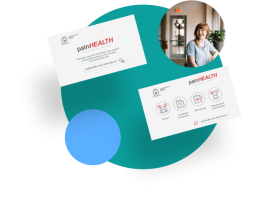Yoga and Pain
Learn how yoga can assist in musculoskeletal pain management and how you may wish to start yoga to form part of your co-management plan
Last updated: 28 Oct 2023 · 8 min read
Yoga is a diverse set of practices and philosophies originating in India which are now popular world-wide. Most popular are the physical postures and breathing techniques. Yoga is a popular form of exercise, stress reduction and self-care and a great tool for managing chronic pain. Anyone can practice yoga. It is found in gyms, yoga schools, hospitals, prisons, childcare centres, and its popularity is growing.
Yoga can be a powerful mind-body tool to support people living with persistent pain. Working out the right type of class and context to begin a yoga practice when you have pain or other health challenges can be hard. This content will help you understand how and why yoga works and practical advice to begin a yoga practice.
What is yoga?
Yoga practiced holistically incorporates postures, breathing practice, meditation and ethics. Originating in India, yoga is a practice which is adopted by people of many different faiths and people without any religious affiliation.
Yoga can be adapted to the individual and taught in one-to-one settings, or in group classes.
Classes often include postures (asana), breathing (pranayama) and meditation (dhyana).
Because yoga works on the mind and body together, people report both physical and mental health benefits.1 Importantly, evidence from current studies of yoga practice for people living with chronic pain including conditions such as rheumatoid arthritis, osteoarthritis, fibromyalgia, low back pain, intermittent claudication, dysmenorrhoea, mechanical neck disorder, spinal cord injury, postpolio syndrome, and patellofemoral pain, indicate that yoga appeared to cause no physical or mental harm to wellbeing.1
For people who have pain or who have experienced trauma, yoga can be an embodiment practice which helps both physical and mental wellbeing. For some, yoga is a spiritual practice and provides a sense of comfort in difficult times and a deeper connection to their life values.
How does yoga work to help pain?
Yoga is a unique practice which works on the connection between mind and body. When yoga techniques are practiced there are positive effects on our nervous system. For example, our heart rate slows down, the body releases less stress hormones and the “relaxation response” is initiated. Yoga uses stretches, balances, breathing techniques and relaxation practices to achieve this.
Yoga can be helpful in addressing some of the movement-related aspects of pain that can contribute to a pain experience, for example, tight muscles and stiff joints. Regular yoga can help to release tension in the body, improve mood, immune system function and generally help you feel good.1 Research suggests that the positive impact on mood and mental health is one of the primary ways yoga works to improve your day to day function, moderate pain and mood. Exercise in general can also deliver similar benefits to your health and wellbeing1, so finding what works for you is key.
Research shows yoga is as safe as usual care and exercise. However, practised incorrectly or without proper supervision yoga can also aggravate pain or create pain flares in the short term.1, 2
There are different types of practices to suit all ages and health conditions. You might find a dynamic flowing sequence of yoga postures, or perhaps a restful and support guided breathing practice is best for you.
Yoga works like other exercises, so regular practice or ‘dose’ is key. Regular, steady practice over time is the most likely way yoga will positively impact your health and wellbeing, including functional capacity, pain and mood.
Yoga is not a quick fix or stand-alone solution for pain and ideally forms one part of a broader pain management plan that is tailored to your priorities and goals.3
What does the research say?
Reviews of the last 20 years of clinical trials suggest that yoga may be helpful for people living with chronic pain in terms of improving what they can do (function), pain and general wellbeing.1,2,4 The size of the benefit of yoga on pain, mood, and function is however small. We still need more high quality studies to figure out for which pain conditions yoga is most effective, as well as what types of yoga are best suited to people living with persisting pain.
Most evidence is for the benefits of yoga in people with chronic back pain, although it can also help arthritis, headache/migraine, irritable bowel syndrome, fibromyalgia, period pain and carpal tunnel syndrome.2,3,4
We also don’t yet fully understand how yoga works to help people experiencing pain, including older adults. Emerging evidence suggests that it might help us more effectively control how we think and feel, both mentally and physically. It might also work by improving muscle flexibility, promoting relaxation, reducing inflammation, increasing the release of pain relieving endorphins, improving confidence and our sense of self control.
Already yoga is widely accepted as a helpful complementary part of pain care, alongside care from your Physiotherapist, Doctor, Psychologist, and health team.
Download our postcard
We've just created a postcard PDF you can download to share with your patients easily.
Can anyone do yoga?
Yes, yoga is suitable for everyone.
While lots of people start yoga on YouTube, for people living with pain, we recommend discussing your plans for yoga or exercise first with your health care provider. Working with your health professional to find a well-trained teacher that you trust and developing a plan that supports your goals is likely to get the best outcome.
When choosing a teacher or class, remember that yoga is currently an unregulated industry. This means that anyone is able to call themselves a yoga teacher and it is hard to know who would be the best teacher for you. A good place to start looking is Yoga Australia, a volunteer organisation that upholds high standards for Yoga Teachers.
Consider seeing a Yoga Therapist, to find an individual practice that fits your needs.
Yoga Therapists have more specialised training and are better positioned to give individual advice. Choose a Yoga Therapist registered with either the International Association of Yoga Therapists or the Australasian Association of Yoga Therapists.
Do you want to try yoga?
Discuss your plans with your health care provider before attempting these practices to ensure the best fit for you – to help get the best benefit with the lowest risk of any pain flares.
Start off slowly with your yoga practice. Remember these tips:
- that for yoga to be effective, it must be practised regularly with your awareness
- always listen to your body during your yoga practice
- while the risk of harm for people living with pain and undertaking yoga is considered low,5 it’s always important to have a conversation with your health professional about the best yoga practice and dose for you.
The following video is a short, gentle chair class with a meditation to give you a taste of yoga.
If you are a physically active person and would like a more dynamic practice, you can consider discussing this practice below with your health care provider and then trying it at home. This practice is especially targeted for people experiencing pain and fatigue.
If you would like to try a Yoga guided relaxation, known as “Yoga Nidra” which means Yogic Sleep, find a comfortable reclined position to practice this meditation.
Do I need to tell my health care professional I am doing yoga?
Yes! It is essential that you advise your health care professional before you commence yoga classes.
You may even wish to ask your health professional to communicate with your yoga teacher/therapist the specifics of your condition.
Further information
For more information about Yoga and Pain management or to find registered yoga teachers and therapists, visit Yoga Australia., the International Association of Yoga Therapists or the Australasian Association of Yoga Therapists.
Alternatively, if you need to speak to your GP or health care professional, please seek further assistance.
Podcast - Pain and peaceful embodiment
Kelly McGonigal - Talks Yoga at Google
NCCIH - Science of Yoga and Pain
- Cramer H, Lauche R, Haller H, Dobos G. A systematic review and meta-analysis of yoga for low back pain. The Clinical journal of pain 2013; 29(5): 450-60. [PubMed]
- Cramer H, Ward L, Saper R, Fishbein D, Dobos G, Lauche R. The Safety of Yoga: A Systematic Review and Meta-Analysis of Randomized Controlled Trials. Am J Epidemiol 2015; 182(4): 281-93. [PubMed]
- Wren AA, Wright MA, Carson JW, Keefe FJ. Yoga for persistent pain: new findings and directions for an ancient practice. Pain 2011; 152(3): 477-80. [PubMed]
- Bussing A, Ostermann T, Ludtke R, Michalsen A. Effects of yoga interventions on pain and pain-associated disability: a meta-analysis. The journal of pain : official journal of the American Pain Society 2012; 13(1): 1-9. [PubMed]
- Eccleston C, Williams AC, Morley S. Psychological therapies for the management of chronic pain (excluding headache) in adults. The Cochrane database of systematic reviews 2009; (2): CD007407. [PubMed]
This module has been developed by Jean Byrne, BA, GradDipEd, DipChildbirthEd, BA(Hons), PhD and Rob Schütze, BA, BJourn, BSc(Psych)Hons, MPsych(Clinical) The information in this module is based on current best evidence research and clinical practice.
SHARE THIS ARTICLE
Pain management information, stories and tips accessible anywhere, anytime.
Access clinically supported practical musculoskeletal pain management information to help you understand pain, how you can manage your pain with your management team on the go on any device.

